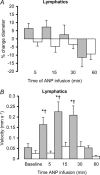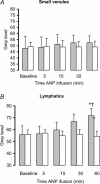Effects of atrial natriuretic peptide on the extrasplenic microvasculature and lymphatics in the rat in vivo
- PMID: 15718260
- PMCID: PMC1464482
- DOI: 10.1113/jphysiol.2005.083147
Effects of atrial natriuretic peptide on the extrasplenic microvasculature and lymphatics in the rat in vivo
Abstract
We developed a novel model using fluorescent intravital microscopy to study the effect of atrial natriuretic peptide (ANP) on the extrasplenic microcirculation. Continuous infusion of ANP into the splenic artery (10 ng min(-1) for 60 min) of male Long-Evans rats (220-250 g, n = 24) induced constriction of the splenic arterioles after 15 min (-7.2 +/- 6.6% from baseline diameter of 96 +/- 18.3 microm, mean +/- S.E.M.) and venules (-14.4 +/- 4.0% from 249 +/- 25.8 microm; P < 0.05). At the same time flow did not change in the arterioles (from 1.58 +/- 0.34 to 1.27 +/- 0.27 ml min(-1)), although it decreased in venules (from 1.67 +/- 0.23 to 1.15 +/- 0.20 ml min(-1)) and increased in the lymphatics (from 0.007 +/- 0.001 to 0.034 +/- 0.008 ml min(-1); P < 0.05). There was no significant change in mean arterial pressure (from 118 +/- 5 to 112 +/- 5 mmHg). After continuous ANP infusion for 60 min, the arterioles were dilated (108 +/- 16 microm, P < 0.05) but the venules remained constricted (223 +/- 24 microm). Blood flow decreased in both arterioles (0.76 +/- 0.12 ml min(-1)) and venules (1.03 +/- 0.18 ml min(-1); P < 0.05), but was now unchanged from baseline in the lymphatics (0.01 +/- 0.001 ml min(-1)). This was accompanied by a significant decrease in MAP (104 +/- 5 mmHg; P < 0.05). At 60 min, there was macromolecular leak from the lymphatics, as indicated by increased interstitial fluorescein isothiocyanate-bovine serum albumin fluorescence (grey level: 0 = black; 255 = white; from 55.8 +/- 7.6 to 71.8 +/- 5.9, P < 0.05). This study confirms our previous proposition that, in the extrasplenic microcirculation, ANP causes greater increases in post- than precapillary resistance, thus increasing intrasplenic capillary hydrostatic pressure (P(c)) and fluid efflux into the lymphatic system. Longer-term infusion of ANP also increases Pc, but this is accompanied by increased 'permeability' of the extrasplenic lymphatics, such that fluid is lost to perivascular third spaces.
Figures





Similar articles
-
Macromolecular leak from extrasplenic lymphatics during endotoxemia.Lymphat Res Biol. 2009;7(3):131-7. doi: 10.1089/lrb.2008.1019. Lymphat Res Biol. 2009. PMID: 19778200
-
LPS abolishes extrasplenic vasoconstriction to atrial natriuretic peptide: the role of NO and endothelin 1.Shock. 2008 Jun;29(6):675-80. doi: 10.1097/shk.0b013e31815811a3. Shock. 2008. PMID: 17885645
-
Atrial natriuretic factor increases splenic microvascular pressure and fluid extravasation in the rat.J Physiol. 2001 May 15;533(Pt 1):273-80. doi: 10.1111/j.1469-7793.2001.0273b.x. J Physiol. 2001. PMID: 11351034 Free PMC article.
-
Pial microvascular responses to transient bilateral common carotid artery occlusion: effects of hypertonic glycerol.J Vasc Res. 2008;45(2):89-102. doi: 10.1159/000109818. Epub 2007 Oct 12. J Vasc Res. 2008. PMID: 17934320
-
Lymphatic biology and the microcirculation: past, present and future.Microcirculation. 2005 Jan-Feb;12(1):141-50. doi: 10.1080/10739680590900003. Microcirculation. 2005. PMID: 15804980 Review.
Cited by
-
The nociceptin/orphanin FQ receptor antagonist UFP-101 reduces microvascular inflammation to lipopolysaccharide in vivo.PLoS One. 2013 Sep 23;8(9):e74943. doi: 10.1371/journal.pone.0074943. eCollection 2013. PLoS One. 2013. PMID: 24086402 Free PMC article.
-
Atorvastatin reduces endotoxin-induced microvascular inflammation via NOSII.Naunyn Schmiedebergs Arch Pharmacol. 2015 May;388(5):557-64. doi: 10.1007/s00210-015-1100-y. Epub 2015 Feb 14. Naunyn Schmiedebergs Arch Pharmacol. 2015. PMID: 25678054
-
Permeability and contractile responses of collecting lymphatic vessels elicited by atrial and brain natriuretic peptides.J Physiol. 2013 Oct 15;591(20):5071-81. doi: 10.1113/jphysiol.2013.260042. Epub 2013 Jul 29. J Physiol. 2013. PMID: 23897233 Free PMC article.
-
Constriction of rat extra-splenic veins to lipopolysaccharide involves endothelin-1.Naunyn Schmiedebergs Arch Pharmacol. 2010 Jun;381(6):555-62. doi: 10.1007/s00210-010-0514-9. Epub 2010 Apr 16. Naunyn Schmiedebergs Arch Pharmacol. 2010. PMID: 20397012
-
Atrial natriuretic peptide modulation of albumin clearance and contrast agent permeability in mouse skeletal muscle and skin: role in regulation of plasma volume.J Physiol. 2010 Jan 15;588(Pt 2):325-39. doi: 10.1113/jphysiol.2009.180463. Epub 2009 Nov 30. J Physiol. 2010. PMID: 19948658 Free PMC article.
References
-
- Andrew PS, Kaufman S. Guanylyl cyclase mediates ANP-induced vasoconstriction of murine splenic vessels. Am J Physiol. 2003;284:R1567–R1571. - PubMed
-
- Atchison DJ, Johnston MG. Atrial natriuretic peptide attenuates flow in an isolated lymph duct preparation. Pflugers Arch. 1996;431:618–624. 10.1007/s004240050043. - DOI - PubMed
-
- Baldwin AL, Thurston G. Mechanics of endothelial cell architecture and vascular permeability. Crit Rev Biomed Eng. 2001;29:247–278. - PubMed
-
- Berg S. Hyaluronan turnover in relation to infection and sepsis. J Intern Med. 1997;242:73–77. - PubMed
-
- Brookes ZL, Brown NJ, Reilly CS. Differential effects of intravenous anaesthetic agents on the response of rat mesenteric microcirculation in vivo after haemorrhage. Br J Anaesth. 2002;88:255–263. - PubMed
Publication types
MeSH terms
Substances
LinkOut - more resources
Full Text Sources
Miscellaneous

